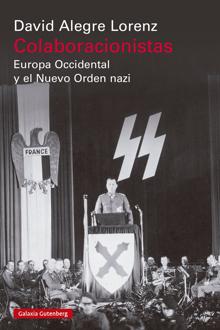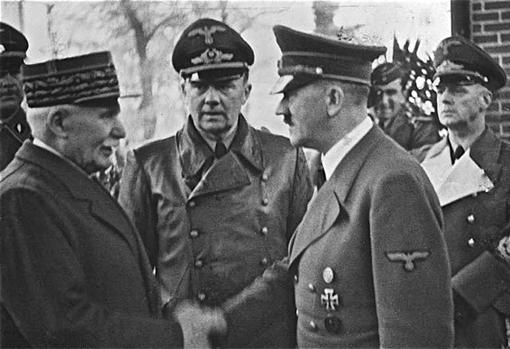![]() CONTINUE
CONTINUE
Collaborationism exudes the acrid and dense stench of disloyalty; something that few can forgive. Although today there is a certain respect towards the Germans who fought in the 'Wehrmacht' – the armed forces of the Third Reich – due to their relative ideologization, the same does not happen with the volunteer units that fought on the Axis side during the Second World War. . David Alegre, a professor at the Department of Modern and Contemporary History at the Autonomous University of Barcelona, tells us that “prison, prosecution and purge for treason against the fatherland” awaited them after the conflict. We had no forgiveness or mercy, as he well explains in his new essay: 'Collaborators' (Galaxia Gutenberg).
“Collaborationism is considered anathema because, in the eyes of an important part of European societies, it involved a frontal questioning of the very idea of national sovereignty, independence and citizenship as conceived since the revolution. French, ”he explained to ABC Alegre.
In addition to words, many people saw in this movement an attempt by their fellow citizens to promote their own interests under the pretext of the struggle for power. And the worst thing is that, in thousands of cases, it was true. "A part of the collaborationists of 1940 and 1941 were opportunists who had just arrived in the ranks of the local fascist parties, careerists who hoped others for a German victory that seemed inevitable at the time," he adds.
back faces
All in all, the phenomenon that Alegre analyzes has two faces. The kindest is that of some women accused of collaborating in liberated France. Those teachers who welcomed German officers into their homes to earn some money were branded as 'boches mattress', shaved to zero in front of the fervent crowd and paraded intrudes to the ridicule of the entire population. An injustice. On the other hand, the setback was sadder and the usual one was the volunteer units that fought during the conflict supported by local fascism with the consent of the Third Reich authorities. The majority, under the umbrella of the 'Wehrmacht' or the fearsome SS.

In his new, conscientious and extensive essay, Alegre focuses on this bitter side of collaborationism. From France to the Netherlands, passing through Denmark or Norway, he reviews the organizations that sided with Germany in World War II, both civil and military. What is striking is that he does not do it from a vengeful or partial perspective, but with the desire to delve into the causes that led this or that group to participate in barbarism. He does not seek to excuse outrages; nor spread a veil of false goodness over them. But it does put their motivations in context.
Only escape has been able to complete the case of Italy and the collaborators of the Balkan territories and the Soviets under Axis control. And not for lack of interest, but because, moreover, the words required a separate work. From now on, the center of these gazes is the westernmost Europe. "My goal has been to illuminate the highlights of collaborationism and the forms of domination of the Reich, along with the policies of European fascism in its attempt to make its projects a reality," he reveals. Everything, through small biographies that link with the great History, the one with a capital H.
justify treason
The areas of betrayal are counted by dozens and depend on the country being analyzed. Among them is the top of the New Order. Namely: the rules that the Third Reich would establish after crushing the old states. It is the idea that the Nazi machine would be unstoppable in pushing much of Europe to adhere to Nazi precepts. The generalization of the commandments promoted by Adolf Hitler through his press organizations and colossal congresses such as the one in Nuremberg – attended by thousands and thousands of foreigners – gave the final push to the small local nationalist and extremist parties. The unstoppable advance of German fighting vehicles through Poland and France made the restaurant.
That gave free rein to barbarism in countries like France or Ukraine. In the first place, in its collaborationist part, the Pétain Government promoted the Winter Velodrome, in which thousands of women and children were deported to the concentration camps of the Third Reich. In this region, local militias carried out countless massacres such as Maropol, north of kyiv. "This, at a time when it was understood by not a few Europeans as the blackest of their respective national histories, made collaboration with the occupier seen as the paradigm of immorality and betrayal," Alegre said in statements to ABC . In most, justice was waiting after the end of World War II.
 Pétain and Hitler, after the invasion and defeat of France in 1940 – ABC
Pétain and Hitler, after the invasion and defeat of France in 1940 – ABC
The response of that shadowy army was mixed. The general excuse was that there was little he could do in the face of the oppressive machinery of the Third Reich. Many of those who collaborated for political reasons, with the idea of testing the German umbrella to relaunch their projects, justified themselves by stating that, thanks to their mediation, the occupation policies were less bloody”, adds Alegre. A shield like any other. In the words of the Spanish professor, it was something similar to what the traditional elites maintained as an argument to keep their factories, state bureaucracies and national courts operating at the service of the Nazis.
What truth did these excuses have? According to Alegre, little: “The experience of contemporaries to the facts and the documentation tell us different things: in many cases, the collaborationists took advantage of their positions of subsidiary authority within the German machinery to prosper, profiting from the plundering of their own fellow citizens. Participating in it and exercising a despotic and violent power against their neighbors”. He thus explained that the armed resistance against the occupation made them and their families their main targets. "Above all, because they were aware that they could not create great problems for the occupying forces and that they would be driven out of their countries by the allied war effort."
enemy interiors
Thus, after World War II, a ruthless hunt began against the old allies of the Germans. "It was about ending the domestic enemy with an eye to the future post-war order, also because killing a collaborationist instead of a German had a much lower repressive cost," the author reveals to ABC. In the words of Alegre, this is also the fracture that collaborationism and the war left behind, with broken local communities, hatred and the vast judicial processes against those political-military allies in the postwar period.
Although this hunt had another objective: to hide individual sins. And it is that, although it has been hidden, there were many citizens who did not present any resistance to the Nazi precepts; Whether out of fear, out of interest or, simply put, out of comfort. “These practices served to create a smoke screen that was intended to hide or simplify the real scope of collaboration at all levels of society, especially by those same old elites who, in many cases, returned to the politics and they needed to hide their responsibility in the military defeat against Nazi Germany and their flirtation with authoritarian state reform plans”, he concludes.
